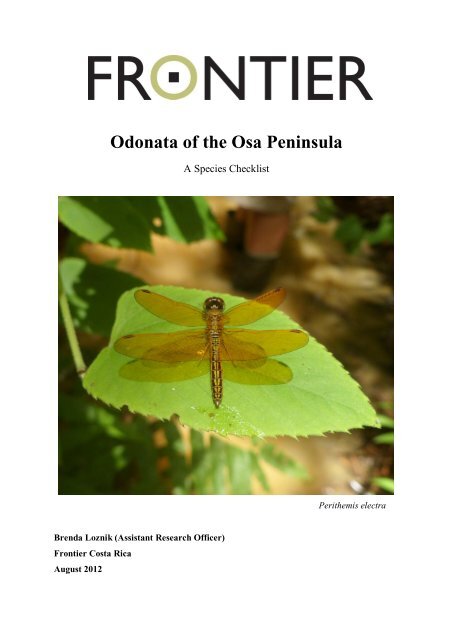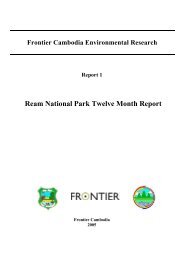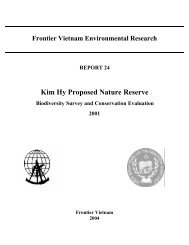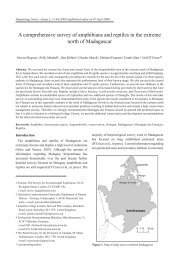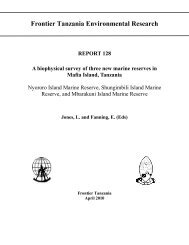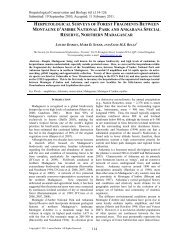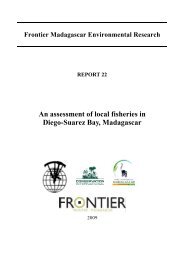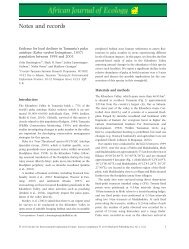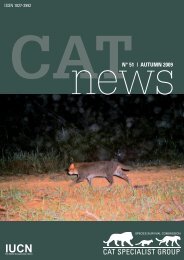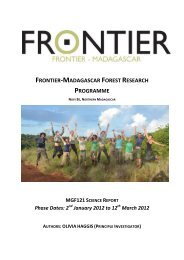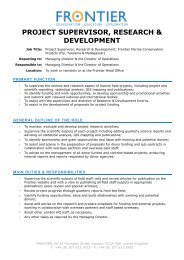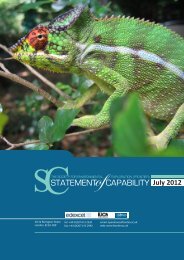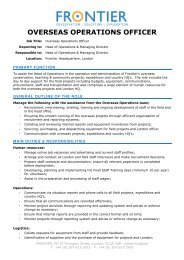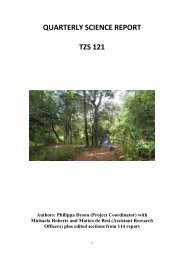Odonata of the Osa Peninsula - Frontier
Odonata of the Osa Peninsula - Frontier
Odonata of the Osa Peninsula - Frontier
You also want an ePaper? Increase the reach of your titles
YUMPU automatically turns print PDFs into web optimized ePapers that Google loves.
<strong>Odonata</strong> <strong>of</strong> <strong>the</strong> <strong>Osa</strong> <strong>Peninsula</strong><br />
Brenda Loznik (Assistant Research Officer)<br />
<strong>Frontier</strong> Costa Rica<br />
August 2012<br />
A Species Checklist<br />
Peri<strong>the</strong>mis electra
Introduction<br />
Dragonflies (Insecta: <strong>Odonata</strong>) are amongst <strong>the</strong> most attractive and captivating groups <strong>of</strong><br />
insects. Their bright colors, aerial acrobatics, large body size and unique mating patterns<br />
capture everyone’s attention. In Latin America, a lack <strong>of</strong> field guides, active researchers and a<br />
widespread ignorance have caused this order to be understudied in comparison to o<strong>the</strong>r parts<br />
<strong>of</strong> <strong>the</strong> world. In a world where land managers are limited by a combination <strong>of</strong> time, money<br />
and personnel constraints, <strong>the</strong> use <strong>of</strong> secondary approaches to monitor biodiversity and detect<br />
change in habitat quality is essential. Dragonflies are excellent invertebrates to include in<br />
monitoring programs because <strong>of</strong> <strong>the</strong>ir usefulness as indicators for assessing both terrestrial<br />
and aquatic habitats (Schmidt, 1985; Corbet, 1993; Chovanec, 2000; Schindler et al. 2003).<br />
Dragonflies can be used as indicators <strong>of</strong> ecological health, ecological integrity, environmental<br />
change and <strong>the</strong> hydrological dynamics <strong>of</strong> water bodies (Clark and Samways, 1996; Moore<br />
1997; Chovanec and Waringer, 2001; Flenner and Sahlen, 2008). There are many advantages<br />
<strong>of</strong> using dragonflies as bioindicators (summarized by Chovanec and Waringer, 2001):<br />
� Advanced knowledge on <strong>the</strong> ecological requirements <strong>of</strong> a large number <strong>of</strong> Odonate<br />
species.<br />
� A high correlation between <strong>the</strong> presence <strong>of</strong> habitat components and <strong>the</strong> presence <strong>of</strong><br />
certain species.<br />
� A relatively small number <strong>of</strong> species (approximately 5.000 worldwide as opposed to<br />
100.000 species <strong>of</strong> butterflies. Esquivel, 2006) which can <strong>of</strong>ten be identified in <strong>the</strong><br />
field.<br />
� A relatively long ontogenetic development makes medium to long-term monitoring<br />
possible.<br />
� They react rapidly to a change in habitat quality by appearance/disappearance or by a<br />
change in abundance.<br />
� They serve as umbrella species representing both aquatic and terrestrial assemblages.<br />
Before <strong>the</strong> use <strong>of</strong> dragonflies can become a common practice in Central America, we need to<br />
fill some <strong>of</strong> <strong>the</strong> gaps in our current knowledge on this order. For example, little is known<br />
about <strong>the</strong> seasonal diversity, behavior, migration patterns and larva-adult associations <strong>of</strong> most<br />
species in this order (Esquivel, 2006). Thereby, very little region specific baseline inventory<br />
lists are published that can be used for conservation planning.<br />
In <strong>the</strong> present study, <strong>the</strong> dragonfly assemblage <strong>of</strong> a forest reserve owned by <strong>Osa</strong> Conservation<br />
on <strong>the</strong> <strong>Osa</strong> <strong>Peninsula</strong> in Costa Rica was studied with <strong>the</strong> overall aim <strong>of</strong> filling some <strong>of</strong> <strong>the</strong><br />
earlier described gaps in our knowledge <strong>of</strong> Central American <strong>Odonata</strong>. The objectives <strong>of</strong> this<br />
study are:<br />
1) To collect baseline presence/absence data to which future surveys can be compared to<br />
in order to detect changes in habitat quality that may have gone unnoticed by humans.<br />
2) To collect data on habitat use and seasonality.<br />
3) To create a photo ID guide <strong>of</strong> <strong>the</strong> species present in <strong>the</strong> area to facilitate future<br />
research efforts.
Site description<br />
Even though Costa Rica covers only 0.01% <strong>of</strong> <strong>the</strong> world’s landmass, it is estimated to have<br />
5% <strong>of</strong> all living species (INBio, 1999). Within Costa Rica, <strong>the</strong> <strong>Osa</strong> <strong>Peninsula</strong> is considered a<br />
biodiversity hotspot comprising over 50% <strong>of</strong> all species despite representing only 3% <strong>of</strong> <strong>the</strong><br />
country’s landmass (Larsen and T<strong>of</strong>t, 2009). Thy dry season lasts from December to April<br />
and <strong>the</strong> wet season between May and November. Mean annual precipitation is 5500 mm and<br />
<strong>the</strong> mean annual temperature 27°C (Sanchez-Az<strong>of</strong>eifa et al. 2002). <strong>Osa</strong> Conservation owns a<br />
1.700 hectares stretch <strong>of</strong> land in Piro, on <strong>the</strong> southwestern slope <strong>of</strong> <strong>the</strong> <strong>Peninsula</strong>. The land<br />
has a well-established trail system that runs through primary and secondary rainforest as well<br />
as coastal habitat.<br />
Dragonflies are in all stages <strong>of</strong> <strong>the</strong>ir life cycle closely tied to aquatic habitats (Esquivel, 2006).<br />
They are known to occupy a wide range <strong>of</strong> aquatic habitats in forests which include seasonal<br />
and permanent pools, seasonal and permanent swamps, lakes, streams, rivers and springs<br />
(Clausnitzer, 2003). In order to get a good picture <strong>of</strong> which species are present in <strong>the</strong> area, 5<br />
different survey sites were selected.<br />
1. The OBC (N 08°24’14.3”, W 083°20’13.0”, 21 m above sea level (a.s.l.), Fig. 1A) is<br />
a large open area where <strong>the</strong> research facilities and volunteer accommodation <strong>of</strong> <strong>Osa</strong><br />
Conservation are located. This site is most heavily disturbed by human presence and<br />
in comparison to <strong>the</strong> o<strong>the</strong>r sites located fur<strong>the</strong>r away from a water source (i.e. <strong>the</strong><br />
nearby Piro River).<br />
2. Ocelotte stream (N 08°24’13.6”, W 083°20’03.2”, 15 m a.s.l. Fig. 1B) is a tributary <strong>of</strong><br />
<strong>the</strong> Quebrada Coyunda river. It is a narrow, shallow, slow-running and undisturbed<br />
stream that is heavily shaded by tall primary forest trees for most parts <strong>of</strong> <strong>the</strong> day.<br />
3. The Piro river (N 08°24’20.3”, W 083°20’20.7”, 35 m a.s.l. Fig. 1C) is a broad river<br />
that in <strong>the</strong> sampling area runs through a small patch <strong>of</strong> secondary forest. The river is<br />
fairly shallow during <strong>the</strong> months <strong>of</strong> <strong>the</strong> dry season when this study was conducted but<br />
deeper pools are present.<br />
4. Piro trail (N 08°23’50.0”, W 083°20’25.9”, 27 m a.s.l. Fig. 1D) is a secondary forest<br />
trail near a large open lagoon formed by <strong>the</strong> Piro river. It is a narrow and shaded trail<br />
but with some open sunny patches.<br />
5. The Swamp (N 08°24’44.7”, W 083°20’46.5”, 27 m a.s.l Fig. 1E-F) is an open grassy<br />
(classed invasive) area located near <strong>the</strong> road that runs towards Carate. The swamp was<br />
mostly dry for <strong>the</strong> first two months <strong>of</strong> <strong>the</strong> survey but filled-up quickly when <strong>the</strong> rain<br />
became more frequent in April which coincided with <strong>the</strong> time when all but a small<br />
patch <strong>of</strong> grass was removed by <strong>Osa</strong> Conservation.
A B<br />
C D<br />
E F<br />
Figure 1: <strong>the</strong> survey sites. A) OBC; B) Ocelotte stream; C) Piro river; D) Piro trail; E) Swamp (February) and<br />
F) Swamp (April). Notice <strong>the</strong> stick in pictures E and F indicating <strong>the</strong> same location in both pictures.
Methods<br />
To account for both seasonal and daily activity patterns, each site was surveyed 16 times in 4<br />
different time slots between January 30 th and May 17 th 2012. Over <strong>the</strong> course <strong>of</strong> a month (4<br />
weeks), each site was visited in <strong>the</strong> early morning (8 AM – 10 AM), late morning (10 AM –<br />
12 AM), early afternoon (1.30 PM – 3.30 PM) and late afternoon (3.30 PM – 5.30 PM).<br />
Because it was not possible to establish transects <strong>of</strong> equal length, sampling was standardized<br />
by 30 minutes <strong>of</strong> intense sampling (excluding <strong>the</strong> time needed for analysis). Adult dragonflies<br />
were netted, measured, photographed and released. For each individual, notes were taken on<br />
time <strong>of</strong> capture, sex, behavior, height <strong>of</strong> perching and whe<strong>the</strong>r it was found in <strong>the</strong> sun or in <strong>the</strong><br />
shade. Because two species <strong>of</strong> <strong>the</strong> genus Uracis (U. imbuta and U. fastigiata) were found to<br />
be extremely abundant and it was feared that capturing <strong>the</strong>se species would severely<br />
underestimate <strong>the</strong>ir abundance, I decided to tally <strong>the</strong>m when <strong>the</strong>y were encountered on a<br />
survey. With <strong>the</strong> help <strong>of</strong> <strong>the</strong> pictures, each individual was later identified to genus and where<br />
possible to species with <strong>the</strong> help <strong>of</strong> Esquivel (2006), Garrison et al. (2006 and 2010) and<br />
Haber and Wagner (2011). Bill Haber kindly provided help in identifying difficult species.<br />
Some species can only be identified with full confidence by examination <strong>of</strong> <strong>the</strong>ir genitalia or<br />
appendages, which was out <strong>of</strong> <strong>the</strong> scope <strong>of</strong> this project. I have identified each individual to <strong>the</strong><br />
best <strong>of</strong> my ability and within <strong>the</strong> limitations <strong>of</strong> a field survey but mistakes could have been<br />
made for species that look very alike or are not formally described. The females <strong>of</strong> two<br />
species <strong>of</strong> <strong>the</strong> genus Argia (A. frequentula and A. pulla) were hard to distinguish in <strong>the</strong> field.<br />
To avoid misidentification, I decided to group <strong>the</strong>se two species toge<strong>the</strong>r as Argia aggregation<br />
(Argia agg.). Some species were encountered outside <strong>of</strong> <strong>the</strong> systematic surveys (between<br />
January 2010 and June 2012). For <strong>the</strong> completeness <strong>of</strong> this study, <strong>the</strong>y are included in <strong>the</strong><br />
species list (Appendix I) and phenology table (Appendix II).<br />
Analysis<br />
Species accumulation curves were made to test whe<strong>the</strong>r <strong>the</strong> five surveyed sites were<br />
adequately sampled. Two non-parametric estimators <strong>of</strong> species richness were generated with<br />
<strong>the</strong> freeware application EstimateS version 8.2.0 (Colwell, 2006). Both parameters are<br />
incidence based (i.e. <strong>the</strong>y rely on presence-absence data) and estimate <strong>the</strong> number <strong>of</strong> species<br />
that are yet to be collected based on a quantification <strong>of</strong> rarity. In <strong>the</strong> case <strong>of</strong> Chao 2 rarity is<br />
quantified as <strong>the</strong> number <strong>of</strong> species that occur in only one (uniques) or two samples<br />
(duplicates) whereas <strong>the</strong> first order jackknife only looks at uniques (Colwell and Coddington,<br />
1994). For each site, a Coleman curve was created, which is <strong>the</strong> incidence-based alternative to<br />
a rarefaction curve that allows more heterogeneity (e.g. temporal and spatial variation in
abundance <strong>of</strong> species between samples) and is <strong>the</strong>refore less likely to overestimate <strong>the</strong><br />
species richness (Colwell et al. 2004).<br />
Results<br />
General<br />
I captured a total <strong>of</strong> 343 individuals (3497 when U. imbuta and U. fastigiata are included)<br />
representing 54 species, belonging to 31 genera and 10 families (8 Anisoptera, 2 Zygoptera,<br />
see Appendix I). Two species could not be identified to genus level and are classified as<br />
Unknown species A and B. A total <strong>of</strong> 39 species were recorded during <strong>the</strong> surveys and an<br />
additional 15 were found on o<strong>the</strong>r occasions. Two families stand out for having both <strong>the</strong> most<br />
genera and species: Libellulidae and Coenagrionidae (Figure 2). The two families combined<br />
comprise ~ 73% <strong>of</strong> <strong>the</strong> species found in <strong>the</strong> area.<br />
A<br />
B<br />
Figure 2: Distribution <strong>of</strong> genera (A) and<br />
species (B) among <strong>the</strong> families found on <strong>Osa</strong><br />
Conservation’s land.
Species distribution patterns<br />
For <strong>the</strong> 49 species that could be identified to species level, <strong>the</strong> broad distribution patterns on<br />
<strong>the</strong> North and South American continents were analyzed based on Esquivel (2006) (Table 1).<br />
The majority <strong>of</strong> <strong>the</strong> species found are widespread in Central and South America (57.1%)<br />
followed by species that are widespread in North, Central and South America (24.5%).<br />
10.2% <strong>of</strong> <strong>the</strong> species only occurs in Central America and 4.1% is confined to <strong>the</strong> Nicaragua-<br />
Costa Rica-Panama region. No species endemic to Costa Rica were found. A small number <strong>of</strong><br />
species are primarily South American species whose nor<strong>the</strong>rn limit is Costa Rica. A similar<br />
small number <strong>of</strong> species is common in both North and Central America. One species,<br />
Telebasis Boomsmae was described from Mexico and Belize but was encountered on several<br />
occasions.<br />
Table 1: Distribution patterns <strong>of</strong> odonata found in <strong>the</strong> study area.<br />
Between site comparisons<br />
Species accumulation curves<br />
Species accumulation curves based on Chao 2 and first order jackknife estimates <strong>of</strong> species<br />
richness are plotted toge<strong>the</strong>r with a Coleman curve and <strong>the</strong> observed species richness (Figure<br />
3). Sample order was randomized 50 times in order to smoo<strong>the</strong>n out <strong>the</strong> curves by reducing<br />
<strong>the</strong> influence <strong>of</strong> sample order. None <strong>of</strong> <strong>the</strong> species accumulation curves shown below have<br />
reached an absolute asymptote indicating that not all species present as <strong>the</strong> sites were found<br />
during <strong>the</strong> surveys. Piro trail appears to be <strong>the</strong> site that was sampled most successfully<br />
whereas many new species await discovery in Ocelotte stream and <strong>the</strong> swamp. Because <strong>of</strong> <strong>the</strong><br />
lack <strong>of</strong> an asymptote, it is not possible to say how many more species are yet to be discovered<br />
For all but two sites (Piro river and <strong>the</strong> Swamp) <strong>the</strong> two estimators are fairly consistent in<br />
<strong>the</strong>ir estimates <strong>of</strong> species richness. For <strong>the</strong> two sites with <strong>the</strong> highest number <strong>of</strong> observed<br />
species (Piro river and <strong>the</strong> Swamp) <strong>the</strong> estimators overestimate <strong>the</strong> species richness when<br />
compared to <strong>the</strong> actual observed number <strong>of</strong> species.<br />
Species Percentage (%)<br />
Middle and South America 28 57.1<br />
Widespread 12 24.5<br />
Primarily Middle America 5 10.2<br />
Nicaragua, Costa Rica and Panama only 2 4.1<br />
Primarily South America 1 2.0<br />
North and Middle America 1 2.0<br />
Costa Rica only 0 0.0
Cumulative number <strong>of</strong> species<br />
45<br />
40<br />
35<br />
30<br />
25<br />
20<br />
15<br />
10<br />
5<br />
0<br />
10<br />
9<br />
8<br />
7<br />
6<br />
5<br />
4<br />
3<br />
2<br />
1<br />
0<br />
0 5 10 15 20<br />
40<br />
35<br />
30<br />
25<br />
20<br />
15<br />
10<br />
5<br />
0<br />
0 5 10 15 20<br />
0 5 10 15 20<br />
Cumulative number <strong>of</strong> samples<br />
A<br />
C<br />
E<br />
14<br />
12<br />
7<br />
Chao2<br />
6<br />
Jacknife 1<br />
5<br />
Coleman<br />
4<br />
Observed3<br />
10<br />
Chao 2<br />
Jacknife 8 1<br />
Coleman 6<br />
Observed<br />
4<br />
10<br />
9<br />
8<br />
2<br />
1<br />
0<br />
2<br />
0<br />
Chao 2<br />
Jacknife 1<br />
Coleman<br />
Observed<br />
0 5 10 15 20<br />
0 5 10 15 20<br />
Cumulative number <strong>of</strong> samples<br />
Figure 3: Species accumulation curves<br />
for <strong>the</strong> OBC (A), Ocelotte stream (B),<br />
Piro river (C), Piro trail (D) and <strong>the</strong><br />
Swamp (E). The non-parametric<br />
parameters <strong>of</strong> richness Chao 2 and firstorder<br />
jackknife (jackknife 1) are plotted<br />
toge<strong>the</strong>r with <strong>the</strong> observed species<br />
richness and a Coleman curve.<br />
B<br />
D<br />
C<br />
Ja<br />
C<br />
O<br />
C<br />
Ja<br />
C<br />
O
Abundance and Richness<br />
Comparisons among sites for total species richness and abundance showed that <strong>the</strong> swamp has<br />
<strong>the</strong> highest species richness but <strong>the</strong> second lowest number <strong>of</strong> individuals. (Figure 5). A similar<br />
situation is found along <strong>the</strong> Piro river where a high species richness is accompanied by a<br />
relatively low abundance. Ocelotte stream has a relative high species richness but <strong>the</strong> lowest<br />
abundance due to a virtual absence <strong>of</strong> Uracis species. The high number <strong>of</strong> individuals<br />
encountered in some sites is greatly influenced by <strong>the</strong> presence <strong>of</strong> Uracis species who occur<br />
in high numbers in forest understory.<br />
Swamp<br />
Piro trail<br />
Piro river<br />
Ocelotte stream<br />
OBC<br />
Species richness and abundance per site<br />
Species richness<br />
0 2 4 6 8 10 12 14 16 18 20<br />
0 250 500 750 1000 1250 1500 1750 2000<br />
Species abundance<br />
Total abundance<br />
Total richness<br />
OBC Ocelotte stream Piro river Piro trail Swamp<br />
Richness 6 10 18 6 19<br />
Abundance 1571 56 365 1083 361<br />
Unique species, that is species that were found in only one <strong>of</strong> <strong>the</strong> five surveyed sites,<br />
represent 26 <strong>of</strong> <strong>the</strong> 39 species observed (Table 2). The Swamp and <strong>the</strong> Piro river are <strong>the</strong> sites<br />
where <strong>the</strong> highest proportion <strong>of</strong> unique species were encountered (respectively73.7% and<br />
50%), followed by <strong>the</strong> Ocelotte stream (20%). The OBC and Piro trail contained virtually no<br />
unique species.<br />
Figure 5: comparisons <strong>of</strong> species richness and abundance for <strong>the</strong> five surveyed sites.
Seasonality<br />
Table 2: Total number <strong>of</strong> unique species found at <strong>the</strong> surveyed sites<br />
Over <strong>the</strong> course <strong>of</strong> this survey, <strong>the</strong> species richness per month stayed practically stable<br />
ranging starting from 26 species in January-February and ending with 23 species in May-June<br />
(Figure 6). A fairly similar number <strong>of</strong> new species was found each month which gives rise to<br />
<strong>the</strong> possibility that more species can be discovered in <strong>the</strong> following months. The stable<br />
species richness even with regular species discoveries is evidence <strong>of</strong> a clear seasonality<br />
pattern where some species disappear and new ones appear (see also Appendix II).<br />
Species richness<br />
60<br />
50<br />
40<br />
30<br />
20<br />
10<br />
0<br />
26<br />
36<br />
28<br />
# <strong>of</strong> unique<br />
February March April May<br />
Month<br />
species<br />
Species richness by month<br />
44<br />
25<br />
Percentage <strong>of</strong> total<br />
Swamp 14 73.7<br />
Piro river 9 50.0<br />
Ocelotte stream 2 20.0<br />
OBC 1 16.7<br />
Piro trail 0 0.0<br />
Figure 6: Overall species richness and cumulative richness per months.<br />
53<br />
23<br />
Species richness<br />
cumulative richness
Discussion<br />
268 species <strong>of</strong> <strong>Odonata</strong> have been found in Costa Rica and at least 13 more species await<br />
formal description (Ramírez et al. 2000). The present survey yielded a total <strong>of</strong> 54 species,<br />
20.2% <strong>of</strong> <strong>the</strong> species currently known to be present in Costa Rica. Thereby, at least two more<br />
species <strong>of</strong> <strong>the</strong> Aeshnidae family were seen but it was not possible to identify <strong>the</strong>se<br />
individuals. Species accumulation curves and <strong>the</strong> fact that new species (i.e. species that are<br />
not included in <strong>the</strong> current species list) were still encountered on a regular basis towards <strong>the</strong><br />
end <strong>of</strong> <strong>the</strong> surveying period suggest that more species await discovery. This can be<br />
contributed to species seasonality and <strong>the</strong> formation <strong>of</strong> new aquatic habitats in <strong>the</strong> wet season.<br />
For this survey I decided only to include individuals that were actually caught. Although this<br />
decision may have underestimated species richness and abundance in some instances, I felt<br />
that <strong>the</strong> advantages <strong>of</strong> this approach outweighed <strong>the</strong> disadvantages. For example, it reduced<br />
biasing this study towards species that are easily identified in <strong>the</strong> field and made identifying<br />
species that look very alike (especially in <strong>the</strong> Coenagrionidae family) easier. Thereby, it<br />
prevented learning over time which would have resulted in biased seasonality patterns. I made<br />
an exception for U. imbuta and U. fastigiata because <strong>the</strong>se species were so abundant that not<br />
tallying <strong>the</strong>m would severally underestimate <strong>the</strong>ir abundance. Even with this approach, it was<br />
not always possible to identify an individual to species or even genus level. In two cases it<br />
was not possible to identify <strong>the</strong> species based on pictures. Bill Haber suggested that Unknown<br />
species A could be an Erythrodiplax or Anatya species and Unknown species B a member <strong>of</strong><br />
<strong>the</strong> Ery<strong>the</strong>mis genus or possibly Erythrodiplax connata or Erythrodiplax kimminsi. The<br />
Psaironeura sp. is probably <strong>the</strong> more common P. remissa that can only be distinguished from<br />
P. selvatica from <strong>the</strong> morphology <strong>of</strong> <strong>the</strong>ir upper appendages. The Perissolestes sp. is ei<strong>the</strong>r P.<br />
remotus or P. magdalenae that again, can only be distinguished from <strong>the</strong>ir cerci.<br />
When comparing this study to that <strong>of</strong> Ramírez et al. (2000), who looked at <strong>the</strong> dragonfly<br />
community <strong>of</strong> Costa Rica as a whole, it stands out that only a small percentage <strong>of</strong> <strong>the</strong> species<br />
found are endemic to Costa Rica or its bordering countries. In a way this is surprising since<br />
<strong>the</strong> <strong>Osa</strong> Pensinsula is <strong>of</strong>ten praised for its high number <strong>of</strong> endemic species. However, most<br />
studies on tropic insects show that species <strong>of</strong>ten have wide ranges and that high levels <strong>of</strong><br />
endemism are <strong>the</strong> result <strong>of</strong> a sampling artifact (Gaston et al. 1996). Not a single member <strong>of</strong><br />
<strong>the</strong> Gomphidae family was found even though this family is relatively species rich in Costa<br />
Rica (Ramírez et al. 2000). Gomphidae generally have cryptic coloration and emerge for<br />
only short periods <strong>of</strong> time and are <strong>the</strong>refore hard to find.<br />
The results <strong>of</strong> this project are a first step towards a possible monitoring program that can<br />
detect early changes in forest composition and water quality and <strong>the</strong> effects <strong>of</strong> management.
Future surveys should include a wider range <strong>of</strong> altitudes and habitats and should be conducted<br />
year-round to determine <strong>the</strong> full composition <strong>of</strong> <strong>the</strong> local <strong>Odonata</strong> community.<br />
Acknowledgements<br />
I would like to thank all <strong>Frontier</strong> volunteers and staff that have helped me catch and<br />
photograph dragonflies. Thereby a special thank to Bill Haber whose help was invaluable.<br />
References<br />
Chovanec, A. 2000. Dragonflies (Insecta: <strong>Odonata</strong>) as indicators <strong>of</strong> <strong>the</strong> ecological integrity <strong>of</strong> aquatic systems—<br />
a new assessment approach. Verhandlungen der Internationalen Vereinigung für Theoretische und<br />
Angewandte Limnologie 27: 887–890.<br />
Chovanec, A. and Waringer, J. 2001. Ecological integrity <strong>of</strong> river-floodplain systems – assessment by dragonfly<br />
surveys (Insecta: <strong>Odonata</strong>). Regulated Rivers: Research and Management 17: 493–507.<br />
Clark, T.E. and Samways, M.J. 1996. Dragonflies (<strong>Odonata</strong>) as indicators <strong>of</strong> biotope quality in <strong>the</strong> Kruger<br />
National Park, South Africa. Journal <strong>of</strong> Applied Ecology 33: 1001-1012.<br />
Clausnitzer, V. 2003. <strong>Odonata</strong> <strong>of</strong> African humid forests – a review. Cimbebasia 18: 173-190.<br />
Colwell, R.K. 2006. EstimateS: Statistical estimation <strong>of</strong> species richness and shared species from samples.<br />
Version 8. < purl.oclc.org/estimates>.<br />
Colwell, R.K. and Coddington, J.A. 1994. Estimating terrestrial biodiversity through extrapolation. Philosophical<br />
Transactions: Biological Sciences 345: 101–118.<br />
Colwell, R.K., Mao, C.X. and Chang, J. 2004. Interpolating, extrapolating, and comparing incidence-based<br />
species accumulation curves. Ecology 85: 2717-2727.<br />
Corbet, P.S. 1993. Are <strong>Odonata</strong> useful as bioindicators? Libellula 12: 91-102.<br />
Esquivel, C. 2006. Libélulas de Mesoamérica y el Caribe. Dragonflies and Damselflies <strong>of</strong> Middle America and<br />
<strong>the</strong> Caribbean. Editorial INBio, Santo Domingo de Heredia, Costa Rica.<br />
Flenner, I. and Sahlen,G. 2008. Dragonfly community re-organisation in boreal forest lakes: rapid species<br />
turnover driven by climate change? Insect Conservation and Diversity 1: 169-179.<br />
Garrison, R.W., von Ellenrieder, N. and Louton, J. 2006. Dragonfly Genera <strong>of</strong> <strong>the</strong> New World: An illustrated<br />
and annotated key to <strong>the</strong> Anisoptera. The John Hopkins University Press, Baltimore, USA.<br />
Garrison, R.W., von Ellenrieder, N. and Louton, J. 2010. Damselfly Genera <strong>of</strong> <strong>the</strong> New World: An illustrated<br />
and annotated key to <strong>the</strong> Zygoptera. The John Hopkins University Press, Baltimore, USA.<br />
Gaston, K.J., Gauld, I.D. and Hanson, P. 1996. The size and composition <strong>of</strong> <strong>the</strong> hymenopteran fauna <strong>of</strong> Costa<br />
Rica. Journal <strong>of</strong> Biogeography 23: 105 – 113.<br />
Haber, W.A. and Wagner, D. 2011. Dragonflies and damselflies: <strong>Odonata</strong> <strong>of</strong> Monteverde, Costa Rica.<br />
http://efg.cs.umb.edu/monteverde/Ode/OdeIntro.html<br />
INBio. 1999. Annual memory. Santo Domingo de Heredia, Costa Rica.<br />
Larsen , T. and T<strong>of</strong>t, R. 2009. <strong>Osa</strong> – where <strong>the</strong> rainforest meets <strong>the</strong> sea. Zona Tropical Publications, China.<br />
Moore, N.W. 1997. Status Survey and Conservation Action Plan: Dragonflies IUCN/SSC <strong>Odonata</strong> Specialist<br />
Group, IUCN, Gland, Switzerland and Cambridge, UK.<br />
Ramírez, A., Paulson, D.R. and Esquivel, C. 2000. <strong>Odonata</strong> <strong>of</strong> Costa Rica: diversity and checklist <strong>of</strong> species.<br />
Revista de Biología Tropical 48: 245 – 252.<br />
Sanchez-Az<strong>of</strong>eifa, A., Rivard, B., Calvo, J. and Moorthy, I. 2002. Dynamics <strong>of</strong> tropical deforestation around<br />
national parks: remote sensing <strong>of</strong> forest change on <strong>the</strong> <strong>Osa</strong> <strong>Peninsula</strong> <strong>of</strong> Costa Rica. Mountain Research<br />
and Development 22: 352-358.<br />
Schindler, M., Fesl, C. and Chovanec, A. 2003. Dragonfly associations (Insecta: <strong>Odonata</strong>) in relation to habitat<br />
variables: a multivariate approach. Hydrobiologia 497: 169 – 180.<br />
Schmidt, E. 1985. Habitat inventarization, characterization and bioindication by a ‘Representative Spectrum <strong>of</strong><br />
<strong>Odonata</strong> Species (RSO)’. Odonatologica 14: 127–133.
Appendix I: <strong>Odonata</strong> Species checklist (current as <strong>of</strong> July 2012)<br />
Anisoptera<br />
Family Species<br />
Calopterygidae Hetaerina fuscoguttata (Selys, 1853)<br />
Hetaerina occisa (Hagen in Selys, 1853)<br />
Hetaerina titia (Drury, 1773)<br />
Coenagrionidae Acanthagrion inexpectum (Leonard, 1977)<br />
Acanthagrion trilobatum (Leonard, 1977)<br />
Argia adamsi (Calvert, 1902)<br />
Argia cupraurea (Calvert, 1902)<br />
Argia difficilis (Selys, 1865)<br />
Argia frequentula (Calvert, 1907)<br />
Argia indicatrix (Calvert, 1902)<br />
Argia pulla (Hagen in Selys, 1865)<br />
Argia translata (Hagen in Selys, 1865)<br />
Ischnura capreolus (Hagen, 1861)<br />
Leptobasis vacillans (Hagen in Selys, 1877)<br />
Metaleptobasis westfalli (Cumming, 1954)<br />
Neoerythromma cultellatum (Selys, 1876)<br />
Telebasis boomsmae (Garrison, 1994)<br />
Telebasis digitocollis (Calvert, 1902)<br />
Lestidae Lestes forficula (Rambur, 1842)<br />
Megapodagrionidae Heteragrion erythrogastrum (Selys, 1886)<br />
Perilestidae Perissolestes sp.<br />
Platystictidae Palaemnema sp.<br />
Protoneuridae Neoneura es<strong>the</strong>ra (Calvert, 1903)<br />
Protoneura amatoria (Calvert, 1907)<br />
Protoneura sulfurata (Donnelly, 1989)<br />
Psaironeura sp.<br />
Pseudostigmatidae Mecistogaster ornata (Rambur, 1842)<br />
Megaloprepus caerulatus (Drury, 1782)
Appendix I continued.<br />
Zygoptera<br />
Family Species<br />
Aeshnidae Gynacantha tibiata (Karsch, 1891)<br />
Libellulidae Anatya normalis (Calvert, 1899)<br />
Brachymesia furcata (Hagen, 1861)<br />
Cannaphila insularis (Kirby, 1889)<br />
Dy<strong>the</strong>mis multipunctata (Kirby, 1894)<br />
Dy<strong>the</strong>mis sterilis (Hagen, 1861)<br />
Ery<strong>the</strong>mis peruviana (Rambur, 1842)<br />
Ery<strong>the</strong>mis vesiculosa (Fabricius, 1775)<br />
Erythrodiplax andagoya (Borror, 1942)<br />
Erythrodiplax castanea (Burmeister, 1839)<br />
Erythrodiplax fervida (Erichson, 1848)<br />
Erythrodiplax funerea (Hagen, 1861)<br />
Erythrodiplax umbrata (Linnaeus, 1758)<br />
Macro<strong>the</strong>mis inequiunguis (Calbert, 1895)<br />
Micrathyria ocellata (Martin, 1897)<br />
Micrathyria dictynna (Ris, 1919)<br />
Or<strong>the</strong>mis discolor (Burmeister, 1839)<br />
Or<strong>the</strong>mis levis (Calvert, 1906)<br />
Or<strong>the</strong>mis schmidti (Buchholz, 1950)<br />
Pantala flavescens (Fabricius, 1798)<br />
Perti<strong>the</strong>mis electra (Ris, 1930)<br />
Tramea calverti (Muttkowski, 1910)<br />
Unknown Sp. A<br />
Unknown Sp. B<br />
Uracis fastigiata (Burmeister, 1839)<br />
Uracis imbuta (Burmeister, 1839)
Appendix II: Phenology <strong>of</strong> <strong>Odonata</strong> on- and <strong>of</strong>f-transect for <strong>the</strong> year 2012. The months in<br />
which each species was captured is indicated with a closed circle. Mating and/or reproductive<br />
behavior is indicated with an open circle. Because <strong>the</strong>re was no systematic sampling conducted<br />
in January and June, observations in <strong>the</strong>se months are indicated with † when <strong>the</strong> species was<br />
only found in January and June or with ‡ when <strong>the</strong> species was also found in January and June.<br />
Species Jan/Feb Mar Apr May/Jun<br />
On transect<br />
Hetaerina fuscoguttata ‡ • • • •<br />
Hetaerina occisa • •<br />
Hetaerina titia ‡ • • •<br />
Acanthagrion inexpectum •<br />
Acanthagrion trilobatum † • •<br />
Argia adamsi ‡ ° • • •<br />
Argia cupraurea • ° ° °<br />
Argia difficilis • •<br />
Argia aggregation ‡ ° • • •<br />
Argia indicatrix † • •<br />
Argia translata °<br />
Leptobasis vacillans •<br />
Metaleptobasis westfalli ° °<br />
Telebasis boomsmae • •<br />
Telebasis digitocollis † •<br />
Lestes forficula ° °<br />
Heteragrion erythrogastrum ‡ ° • • •<br />
Palaemnema sp. •<br />
Neoneura es<strong>the</strong>ra •<br />
Protoneura amatoria † ° •<br />
Psaironeura sp. •<br />
Anatya normalis • • •<br />
Cannaphila insularis •<br />
Dy<strong>the</strong>mis multipunctata • •<br />
Dy<strong>the</strong>mis sterilis † • • •<br />
Ery<strong>the</strong>mis peruviana ‡ • •<br />
Erythrodiplax andagoya • •<br />
Erythrodiplax castanea •<br />
Erythrodiplax fervida • • •<br />
Erythrodiplax funerea • • • •<br />
Erythrodiplax umbrata •<br />
Macro<strong>the</strong>mis inequiunguis •<br />
Micrathyria dictynna •<br />
Micrathyria ocellata •<br />
Unknown sp. A •<br />
Unknown sp. B °<br />
Uracis fastigiata • • • •<br />
Uracis imbuta ‡ • • • •
Appendix II continued.<br />
Species Jan/Feb Mar Apr May/Jun<br />
On transect<br />
Ischnura capreolus † •<br />
Neoerythromma cultellatum •<br />
Perissolestes sp. •<br />
Protoneura sulfurata † •<br />
Mecistogaster ornata † • •<br />
Megaloprepus caerulatus † •<br />
Gynacantha tibiata † • •<br />
Brachymesia furcata •<br />
Ery<strong>the</strong>mis vesiculosa † •<br />
Or<strong>the</strong>mis discolor •<br />
Or<strong>the</strong>mis levis † •<br />
Or<strong>the</strong>mis schmidti •<br />
Pantala flavescens ‡ •<br />
Perti<strong>the</strong>mis electra † •<br />
Tramea calverti †<br />
•
Appendix III: <strong>Odonata</strong> <strong>of</strong> <strong>the</strong> <strong>Osa</strong> <strong>Peninsula</strong>. A picture ID-guide <strong>of</strong> <strong>the</strong> species found between January and June 2012<br />
Anisoptera – Calopterygidae<br />
Hetaerina fuscoguttata ♂<br />
Hetaerina occisa ♀<br />
© W.A. Haber 2004-2011<br />
Coenagrionidae<br />
Acanthagrion inexpectum ♂<br />
Argia adamsi ♀<br />
© W.A. Haber 2004-2011<br />
Hetaerina fuscoguttata ♀ Hetaerina occisa ♂<br />
Hetaerina titia ♂ Hetaerina titia ♀<br />
Acanthagrion inexpectum ♀<br />
© W.A. Haber 2004-2011<br />
Acanthagrion trilobatum ♀<br />
© W.A. Haber 2004-2011<br />
Argia cupraurea ♂<br />
Acanthagrion trilobatum ♂<br />
Argia adamsi ♂
Argia cupraurea ♀ Argia difficilis ♂<br />
© W.A. Haber 2004-2011<br />
Argia difficilis ♀<br />
© W.A. Haber 2004-2011<br />
Argia frequentula ♂<br />
© W.A. Haber 2004-2011<br />
Argia indicatrix ♂ Argia indicatrix ♀<br />
© W.A. Haber 2004-2011<br />
Argia pulla ♀<br />
© W.A. Haber 2004-2011<br />
Ischnura capreolus ♂<br />
© W.A. Haber 2004-2011<br />
Argia translata ♂<br />
© W.A. Haber 2004-2011<br />
Ischnura capreolus ♀<br />
© W.A. Haber 2004-2011<br />
Argia frequentula ♀<br />
Argia pulla ♂<br />
Argia translata ♀<br />
Ischnura capreolus ♀ (immature)
Leptobasis vacillans ♂<br />
© W.A. Haber 2004-2011<br />
Leptobasis vacillans ♀<br />
Metaleptobasis westfalli ♂ Neoerythromma cultellatum ♂<br />
Lestidae<br />
Lestes forficula ♂<br />
Neoerythromma cultellatum ♀<br />
© W.A. Haber 2004-2011<br />
Telebasis digitocollis ♂<br />
Telebasis boomsmae ♂<br />
Lestes forficula ♀
Heteragrion erythrogastrum ♀ Perilestidae<br />
Perissolestes sp. ♂ - © W.A. Haber 2004-2011<br />
Perissolestes sp ♀<br />
© W.A. Haber 2004-2011<br />
Protoneuridae<br />
Neoneura es<strong>the</strong>ra ♂<br />
Megapodagrionidae<br />
Heteragrion erythrogastrum ♂<br />
Platystictidae<br />
Palaemnema sp. ♀<br />
Neoneura es<strong>the</strong>ra ♀<br />
© W.A. Haber 2004-2011<br />
Protoneura amatoria ♀<br />
Protoneura amatoria ♂
Protoneura sulfurata ♂ Protoneura sulfurata ♀<br />
© W.A. Haber 2004-2011<br />
Psaironeura sp. ♂<br />
Pseudostigmatidae<br />
Mecistogaster ornata ♂ - © W.A. Haber 2004-2011<br />
© W.A. Haber 2004-2011<br />
Megaloprepus caerulatus ♀<br />
© W.A. Haber 2004-2011<br />
Libellulidae<br />
Anatya normalis ♂<br />
Mecistogaster ornata ♀<br />
© W.A. Haber 2004-2011<br />
Zygoptera – Aeshnidae<br />
Gynacantha tibiata ♂<br />
Psaironeura sp. ♀<br />
© W.A. Haber 2004-2011<br />
Megaloprepus caerulatus ♂<br />
© W.A. Haber 2004-2011<br />
Anatya normalis ♀<br />
© W.A. Haber 2004-2011
Brachymesia furcata ♂ Cannaphila insularis ♂<br />
© W.A. Haber 2004-2011<br />
Cannaphila insularis ♀ (immature)<br />
Dy<strong>the</strong>mis multipunctata ♀<br />
Dy<strong>the</strong>mis sterilis ♀<br />
© W.A. Haber 2004-2011<br />
Ery<strong>the</strong>mis peruviana ♀<br />
Dy<strong>the</strong>mis multipunctata ♂<br />
© W.A. Haber 2004-2011<br />
Dy<strong>the</strong>mis sterilis ♂<br />
Ery<strong>the</strong>mis peruviana ♂
Ery<strong>the</strong>mis vesiculosa ♂ Ery<strong>the</strong>mis vesiculosa ♀<br />
© W.A. Haber 2004-2011<br />
Erythrodiplax andagoya ♀<br />
© W.A. Haber 2004-2011<br />
Erythrodiplax castanea ♀<br />
© W.A. Haber 2004-2011<br />
Erythrodiplax andagoya ♂<br />
Erythrodiplax castanea ♂<br />
Erythrodiplax fervida ♂<br />
Erythrodiplax fervida ♀ Erythrodiplax funerea ♂<br />
Erythrodiplax funerea ♀<br />
Erythrodiplax umbrata ♂<br />
© W.A. Haber 2004-2011
Erythrodiplax umbrata ♀<br />
© W.A. Haber 2004-2011<br />
Macro<strong>the</strong>mis inequiunguis ♂<br />
© W.A. Haber 2004-2011<br />
Micrathyria ocellata ♂<br />
Macro<strong>the</strong>mis inequiunguis ♀<br />
Micrathyria ocellata ♀<br />
© W.A. Haber 2004-2011<br />
Micrathyria dictynna ♂ Micrathyria dictynna ♀<br />
© W.A. Haber 2004-2011<br />
Or<strong>the</strong>mis discolor ♂ Or<strong>the</strong>mis discolor ♀<br />
© W.A. Haber 2004-2011<br />
Or<strong>the</strong>mis levis ♂<br />
Or<strong>the</strong>mis levis ♀<br />
© W.A. Haber 2004-2011
Or<strong>the</strong>mis schmidti ♂<br />
Unknown species B ♀<br />
Pantala flavescens ♀<br />
© W.A. Haber 2004-2011<br />
Tramea calveri ♂<br />
© W.A. Haber 2004-2011<br />
Unknown species A ♀<br />
Pantala flavescens ♂<br />
Perti<strong>the</strong>mis electra ♂<br />
Tramea calverti ♀<br />
Uracis fastigiata ♂
Uracis fastigiata ♀<br />
Uracis imbuta ♀<br />
© Brenda Loznik<br />
© W.A. Haber 2004-2011 http://efg.cs.umb.edu/monteverde/Ode/OdeIntro.html<br />
Uracis imbuta ♂<br />
© W.A. Haber 2004-2011


